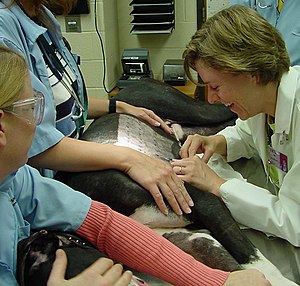Just like people, dogs may have
allergies to trees, grasses, weeds, molds, dust, and many other
 Image via Wikipedia - House Dust Mite
Image via Wikipedia - House Dust Mite
 Image via Wikipedia - dog's allergy skin test
Image via Wikipedia - dog's allergy skin test
things. Allergies can present seasonally, Spring and Fall, or year-round depending on the
allergen. While a few dogs show the typical runny eyes, runny nose, and sneezing like a person with “hay fever,” most dogs will just itch. The dog may rub its face and ears, lick its feet or groin area, or scratch its armpits. Allergies are common in all breeds of dogs and usually manifest themselves when a dog is between one and three years of age. Diagnosis is based on the presence of clinical signs and by ruling out other causes of itching. There are two types of allergy testing that also may be used for diagnosis. The traditional allergy test is called an intra-dermal test and is done by injecting small amounts of allergens into the skin and observing for reactions. The second test uses a blood sample to detect the presence of immune cells against specific allergens. Once diagnosed, allergies can be treated a number of ways. Antihistamines and corticosteroids can be used to relieve itching, but do not solve the underlying allergy. Medicated shampoos and certain omega fatty acids may also help to control clinical signs. “Allergy injections” are based on allergy testing results and can be given at specific intervals in an attempt at desensitization. Desensitization is designed to reduce or eliminate the body’s response to an allergen and may provide a “cure” for your dog’s allergies. If your dog seems a little more “itchy” than usual, help may be available. Talk to your veterinarian today.
~Chad Smith, D.V.M.
 Image via Wikipedia - House Dust Mite
Image via Wikipedia - House Dust Mite Image via Wikipedia - dog's allergy skin test
Image via Wikipedia - dog's allergy skin test Image via Wikipedia - House Dust Mite
Image via Wikipedia - House Dust Mite Image via Wikipedia - dog's allergy skin test
Image via Wikipedia - dog's allergy skin test
No comments:
Post a Comment